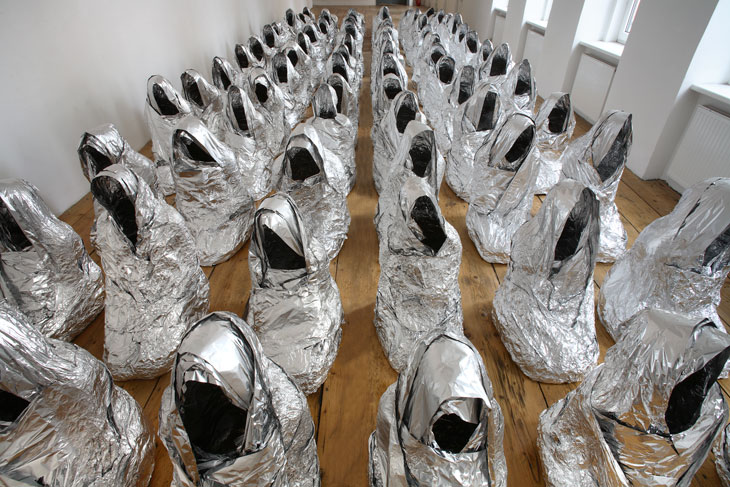Click HERE to have your say about this article – at SEESMIC video discussion
We enjoyed immensly our visit to Unveiled: New art from the middle-east at London’s Saatchi Gallery. This ‘review’ is about Ghost by Kader Attia – and how it is great work – including for teachers or home-schoolers. (Exhibition ends 9th May 2009)

Kader Attia – Ghost – 2007 – Aluminium foil – Dimensions variable – Saatchi Gallery, London
In Ghost, a large installation of a group of Muslim women in prayer, Attia renders their bodies as vacant shells, empty hoods devoid of personhood or spirit. Made from tin foil – a domestic, throw away material – Attia’s figures become alien and futuristic, synthesising the abject and divine. Bowing in shimmering meditation, their ritual is equally seductive and hollow, questioning modern ideologies – from religion to nationalism and consumerism – in relation to individual identity, social perception, devotion and exclusion. Attia’s Ghost evokes contemplation of the human condition as vulnerable and mortal; his impoverished materials suggest alternative histories or understandings of the world, manifest in individual and temporal experience. (This is the gallery description)
-0-
Draft Notes for suggested lessons:
I always admire simplicity – creating a profound piece just by wrapping aluminium foil around a room full of kneeling women – great simplicity.
Presence and absence – traces – how and it what ways do people live on.
Why might the artist have called the piece Ghost as opposed to Ghosts? Which do you prefer and why?
What makes a person a person?
Which bits of the gallery description of Ghost make good sense to you – and which don’t – and why?
Two of the most important concerns in a person’s development are 1) identity – who am I? and 2) purpose – what am I dedicating my life to? What has Ghost to do with identity and purpose?
How powerful might it be if, as a performance piece, a real live woman came and filled one of the places? Would you dress her in aluminium or not – how else would you dress her? Would she speak to the audience? What would she say?
The aluminium creates boundaries, forms – of people who were/are/aren’t no more. Is there spirit to go with the form – or not? If so what is it – where is it – whose spirit is it?
What are your feelings about the women whose forms gave rise to the ghost/s?
How might a fundamentalist respond to this piece? How might a modern believer respond to this piece?
Create a conversation betwen two such people.
What would the whole thing be like if the women had been from Christian/Jewish/Hindu/Buddhist etc background?
What conclusions do you come to as a result of viewing the photograph – or better still having visited the exhibition?
How would you use your/the above ideas to make your own art?

